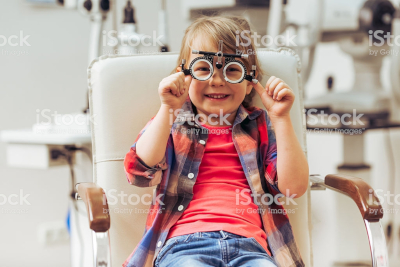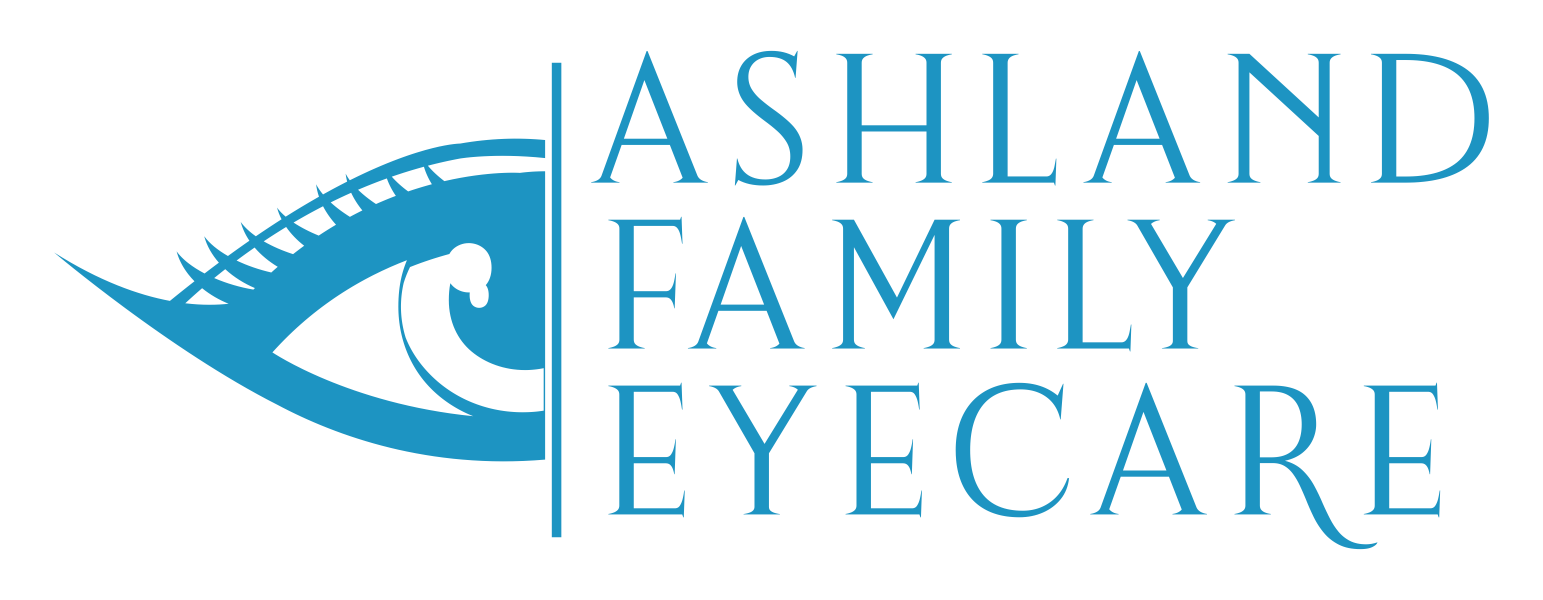
It is important for parents to understand that a screening at a pediatrician’s office or at a school is not the same as the comprehensive exam that is performed by an eye doctor.
Passing a vision screening does not signify
a clean bill of eye health.
Vision screenings are limited; they cannot detect serious eye diseases such as cataracts, glaucoma and macular degeneration. Vision screenings are brief tests that can help determine whether someone is at risk for common vision problems such as nearsightedness and farsightedness. In most cases, vision screenings only check a person’s visual acuity (clarity of vision at a distance). This involves identifying the smallest letters you can read on a vision chart (Snellen chart). Only an eye doctor can conduct a comprehensive eye exam. Not only do comprehensive eye exams test visual acuity, they also evaluate the health of the eyes, from front to back using special tests and equipment. Tests can include those that check signs for cataracts, glaucoma and detached retina. Depending on the specific tests performed, an eye exam can take one to two hours to complete.
According to experts, 80% of learning is visual, which means that if your child is having difficulty seeing clearly, his or her learning can be affected. This also goes for infants who develop and learn about the world around them through their sense of sight. To ensure that your children have the visual resources they need to grow and develop normally, their eyes and vision should be checked by an eye doctor at certain stages of their development.
According to the American Optometric Association (AOA) children should have their eyes examined by an eye doctor at 6 months, 3 years, at the start of school, and then at least every 2 years following. If there are any signs that there may be a vision problem or if the child has certain risk factors (such as developmental delays, premature birth, crossed or lazy eyes, family history or previous injuries) more frequent exams are recommended. A child that wears eyeglasses or contact lenses should have his or her eyes examined yearly. Children’s eyes can change rapidly as they grow.
The toddler and preschool age is a period where children experience drastic growth in intellectual and motor skills. During this time they will develop the fine motor skills, hand-eye coordination and perceptual abilities that will prepare them to read and write, play sports and participate in creative activities such as drawing, sculpting or building. This is all dependent upon good vision and visual processes. This is the age when parents should be on the lookout for signs of lazy eye (amblyopia) – when one eye doesn’t see clearly, or crossed eyes (strabismus) – when one or both eyes turns inward or outward. The earlier these conditions are treated, the higher the success rate.
Parents should also be aware of any developmental delays having to do with object, number or letter recognition, color recognition or coordination, as the root of such problems can often be visual. If you notice your child squinting, rubbing his eyes frequently, sitting very close to the TV or reading material, or generally avoiding activities such as puzzles or coloring, it is worth a trip to the eye doctor.
Undetected or uncorrected vision problems can cause children and teens to suffer academically, socially, athletically and personally. If your child is having trouble in school or after-school activities there could be an underlying vision problem. Proper learning, motor development, reading, and many other skills are dependent upon not only good vision, but also the ability of your eyes to work together. Children that have problems with focusing, reading, teaming their eyes or hand-eye coordination will often experience frustration, and may exhibit behavioral problems as well. Often they don’t know that the vision they are experiencing is abnormal, so they aren’t able to express that they need help.
In addition to the symptoms written above, signs of vision problems in older children include:
- Short attention span
- Headaches
- Frequent blinking
- Avoiding reading
- Tilting the head to one side
- Losing their place often while reading
- Double vision
- Poor reading comprehension
The Eye Exam
In addition to basic visual acuity (distance and near vision) an eye exam may assess the following visual skills that are required for learning and mobility:
- Binocular vision: how the eyes work together as a team
- Focusing
- Peripheral Vision
- Color Vision
- Hand-eye Coordination
- Tracking
The doctor will also examine the area around the eye and inside the eye to check for any eye diseases or health conditions. You should tell the doctor any relevant personal history of your child such as a premature birth, developmental delays, family history of eye problems, eye injuries or medications the child is taking. This would also be the time to address any concerns or issues your child has that might indicate a vision problem.
If the eye doctor does determine that your child has a vision problem, they may discuss a number of therapeutic options such as eyeglasses or contact lenses, an eye patch, vision therapy or Ortho-k, depending on the condition and the doctor’s specialty. Since some conditions are much easier to treat when they are caught early while the eyes are still developing, it is important to diagnose any eye and vision issues as early as possible.
Following the guidelines for children’s eye exams and staying alert to any signs of vision problems can help your child to reach his or her potential.
Why use dilating eye-drops in a pediatric eye exam?
Children examined usually receive eye-drops as part of their comprehensive eye examination. Parents and schools sometimes ask us why it is so important to use eye drops. Parents can worry about the effect on their child. School personnel can be concerned it might present difficulty when the child returns to class after the exam is finished. These are good and appropriate questions to be asking.
- Detection of vision disorders: Even the most experienced pediatric ophthalmologists and optometrists in the multi-center study missed detecting, at least 10% of the time, significant degrees of hyperopia (farsightedness) and amblyopia (lazy eye) – the two leading causes of vision problems in young children. Less experienced eye doctors who do not specialize in the care of young children will potentially miss more. Dilating eye drops minimize this failure to detect.
- Eye exam thoroughness: It is impossible to view more than 15% of the inside and back of the child’s eye without dilating the pupil. Use of dilating eye drops allows a thorough viewing of the inside of the eye by the eye doctor, so eye health and a wide range of ocular and systemic disorders can be assessed.
- Non-verbal and young children: Young children cannot verbally provide a clear and accurate description of their vision problems, and are frequently unaware of the presence of those problems. Objective (not subjective) testing procedures, without having the child provide typical eye exam answers like “which is better, one or two”, is necessary. Eye drops are essential in this task.
Older Children: For older children, the use of dilating drops ensures that the exam is accurate, the eyes and health have been thoroughly and objectively examined, and treatment, including glasses, is prescribed to the best corrected vision.
Standard of Care: The use of dilating drops is the “standard of care” in all health care guidelines established by ophthalmology, optometry, public health, and insurance companies, and is expected by pediatricians, public health and public policy authorities throughout the U.S.A.
How are the dilating drops instilled?
Generally, the child leans their head back and typically two sets of the drops are quickly placed into the eyes. The excess is wiped dry. The child goes out to the waiting area while they wait for the drops to work (about 25 minutes).
How will the drops affect the child?
The pupils will generally be larger for several hours. In very rare cases the dilation might last into the next day. This is a normal reaction and depends upon the type of eye drops used and the color of the child’s eyes. The vision may be blurred at near for a few hours, but rarely the next day. Most children are not affected very much and continue to function well in class.
Drops can feel slightly uncomfortable for a few seconds, or there may be sensitivity to bright light. Disposable sunglasses are given to all young children who might be playing outside that day. With the exception of some older children (over 10 years of age), reading smaller print does not create much of a problem afterwards. Young children in preschool seem to be affected very little.
Conclusion:
A comprehensive eye exam, performed to the standards stated above, may create blurriness from 3-24 hours (depending on the type of drops that are utilized). This time should be compared to the potential life-impairing effects for a child experiencing continued blurry vision from an undiagnosed and untreated vision problem throughout their time in school. The dilated eye exam conclusively and effectively rules out, or highlights, a vision problem as a potential obstacle in a child’s learning process, their social interactions, and their overall health and well-being.
